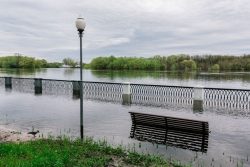This week the Carolina’s experienced a 100-year flood. Over the last three-years, Houston experienced three 500-year floods. What’s happening? How can these rare events occur with such a high frequency?
100-Year Floods Suffer From a Naming Problem
First off, the name 100-year flood is misleading. Instead, the 100-year flood should be renamed to be a “1% probability flood.” This is because there is a 1% probability the flood will occur in any given year.
While mathematically a 1% probability of happening in any given year translates into an occurrence of once per 100-years, that’s not how weather works. Storms aren’t scheduled. Instead, storms occur randomly. Therefore, implying that storms of a certain magnitude occur every x many years is misleading. The reality of weather is that a 100-year flood can happen multiple years in a row.
History Isn’t Always a Good Predictor of the Future
Frequency analysis is used to estimate the probability of storms of varying magnitude occurring. A minimum of ten-years of data is used to perform frequency analysis. More than ten-years of data can provide a more accurate calculation of the frequency and probability. However, with the changing climate, more data doesn’t necessarily mean more accuracy.
The Need for High-Quality Data
As a rating service, ValChoice likes to draw the analogy of user surveys and online reviews vs. analyzing high-quality data. Users surveys and online reviews are notoriously unreliable when it comes to grading insurance companies. Importantly, having more low-quality data doesn’t lead to higher quality data. That’s why at ValChoice we only use high-quality data.
Do you ever wonder how your insurance company behaves when you need them most? Now is a good time to get a free ValChoice report on your auto and home insurance. Click the button below to get your free rating from ValChoice.
How Much Data is Enough?
The problem with low-quality weather data is particularly apparent. As a case-in-point, think about if we doubled the amount of data by collecting data further back in time. However, the data further back in time may be lower quality. Unfortunately, lower-quality data will yield misleading results. Reasons the older data could be less accurate include items such as:
- Rainfall amounts are increasing during storms
- The terrain on which the rain is falling has changed due to increased population
What Homeowners Need to Know
Independent of the data used or the method for calculating frequency, homeowners need to know one important fact. Your homeowners insurance will not cover flood damage. You need to buy flood insurance in order to have protection from the damage of floodwaters.
Many homeowners are reluctant to buy flood insurance because it’s an additional cost. However, homeowners should view flood insurance as a great investment. Flood insurance through the National Flood Insurance Program (NFIP) is a boon to policyholders, at the expense of tax payers. The NFIP is in a nearly continuous state of insolvency. Members of Congress from low-lying coastal states are big supporters of the NFIP because it repeatedly pays to help rebuild the local economies of their constituents. Many of these homes are built in areas where no one would spend their own money to build or repair. Therefore, federal funds are necessary.
If you live in a low lying area, you should consider flood insurance.


No comments yet.